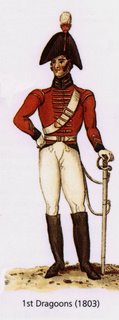King's German Legion infantary depart Portsmouth for Ireland.
"Line battalions and two first line brigades depart Portsmouth for Cork"
from Beamish, North Ludlow, History of the King's German Legion Vol. 1, p90
Sunday, February 26, 2006
Friday, February 24, 2006
Introduction

Historical background
The hiring of mercenaries in England is not isolated to this period. England has a long tradition of using German and other nationalities to augment the army as required. This tradition dates back to at least the 16th century; at this time Henry VIII employed German Landesknechts for his campaigns in Scotland and France. This tradition continued up to the 19th century.
The House of Hanover ruled Britain from 1714 to 1901. The two countries were jointly ruled until 1837 when Victoria came to power. By Salic Law the ruler of Hanover could not be a woman so succession to Hanover went to Ernest Augustus, Duke of Cumberland and brother of William VI. The King’s and Queen from the House of Hanover were as follows: George I (1714-1727), George II (1727-1760), George III (1760-1820), George IV (1820-1830), William VI (1830-1837), Victoria (1837-1901)
The daughter of George II from his first marriage was married into the royal house in Hessen-Kasell. George III son the Prince of Wales was married to Caroline of Brunswick.
The over-extended empire meant that England was always in need of troops to keep order. The German states proved to be a steady source of troops throughout the rule of the Hanoverians. The German states provided troops because it was income for the state or because the army was disbanded.
King’s German Legion
Napoleon’s forces invaded Hanover in June 1803. In July a treaty was signed. One of the terms of the treaty was that the Hanoverian army was to be disbanded. The soldiers went to England and formed the King’s German Legion (9,000 men). In February of 1806 the KGL started to arrive in Ireland. The last of the troops left Ireland in October of 1811.
Subscribe to:
Posts (Atom)